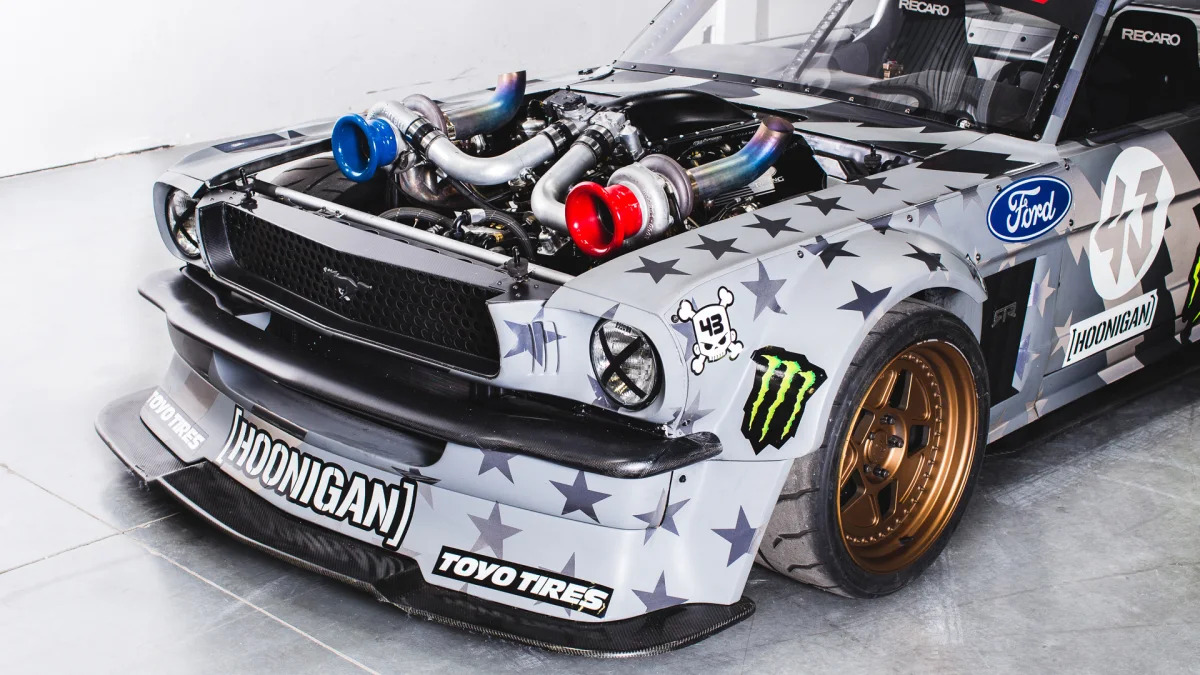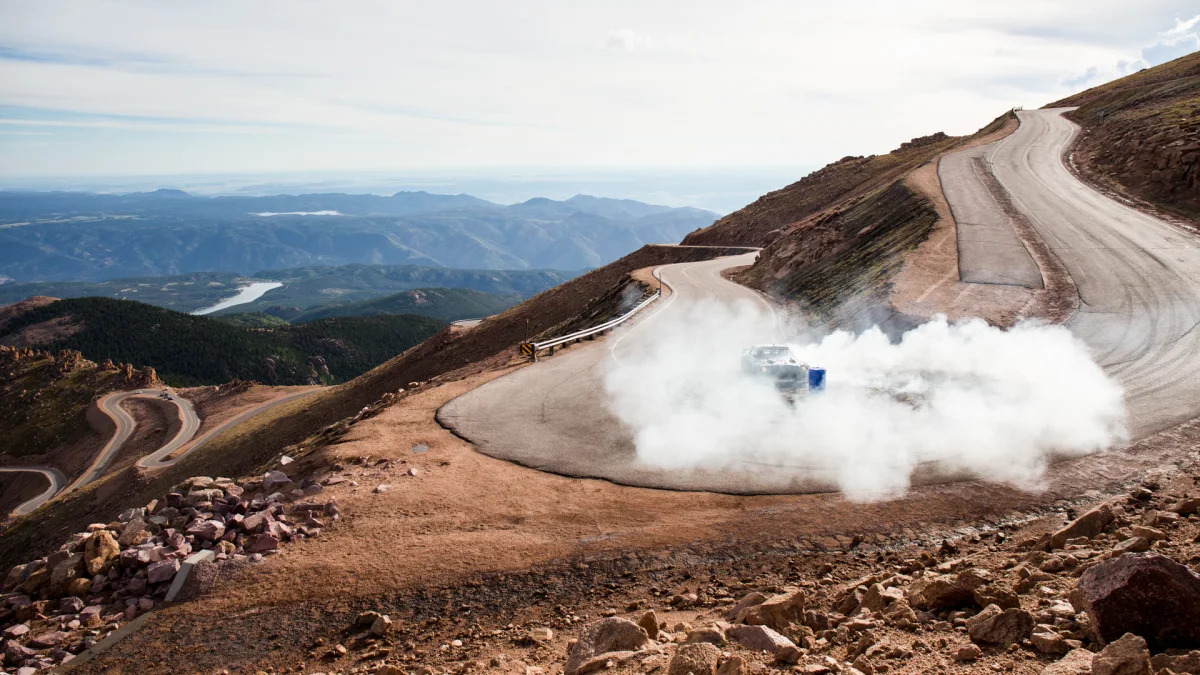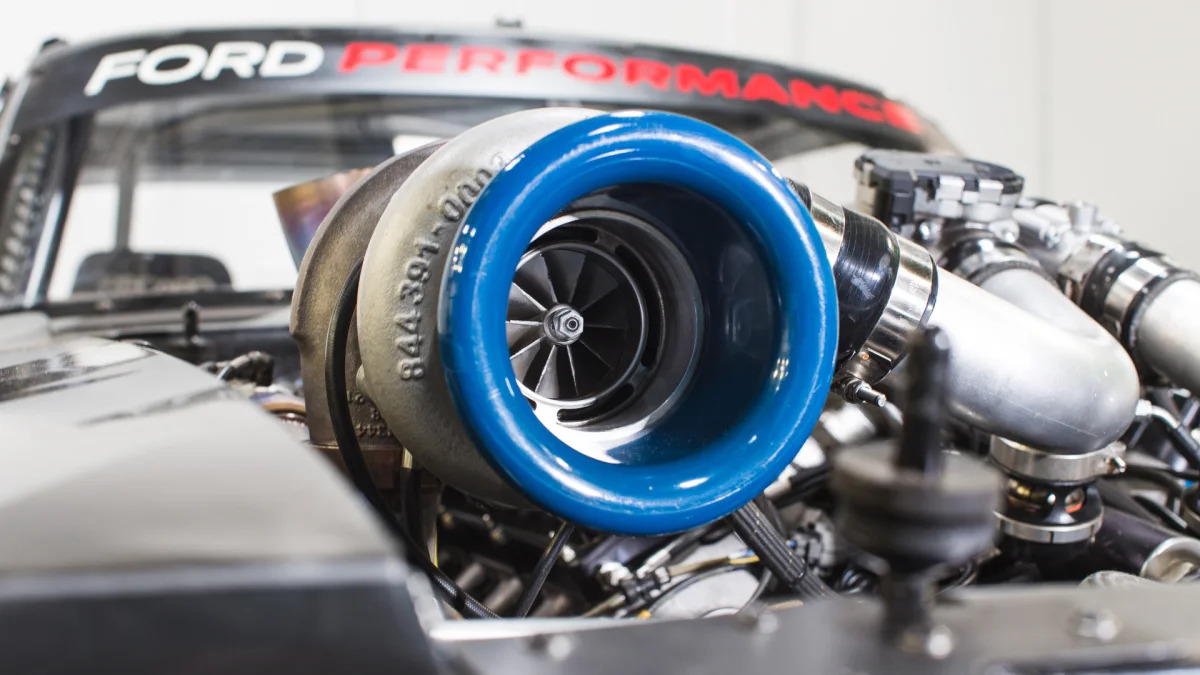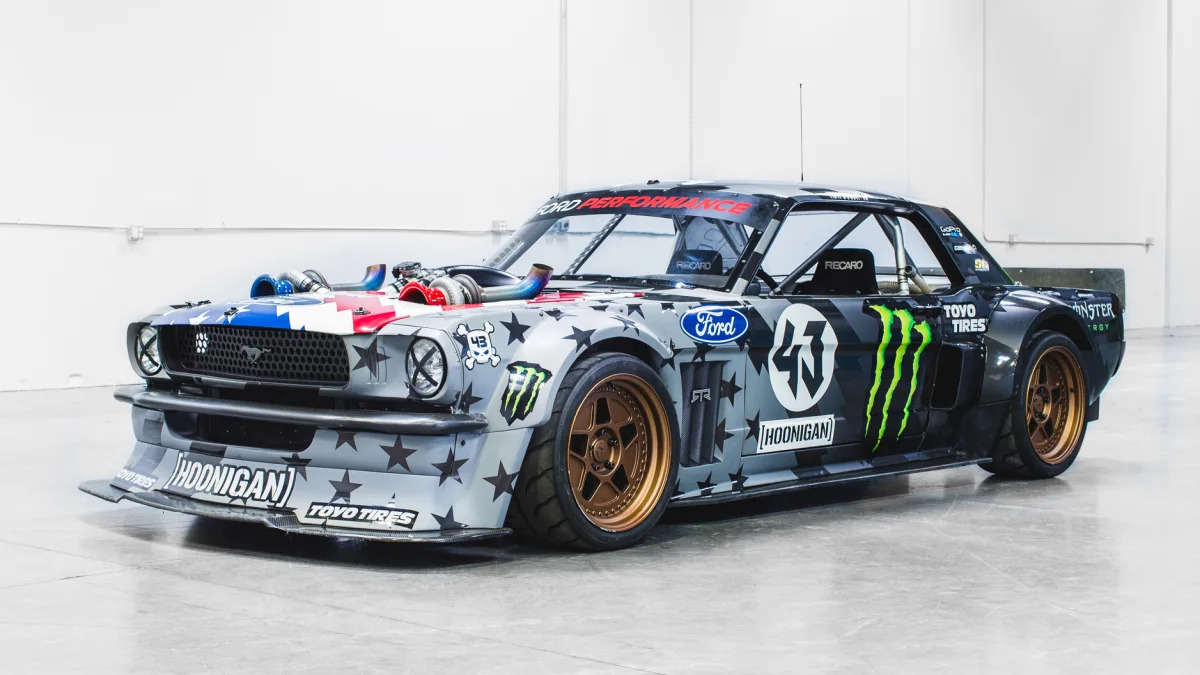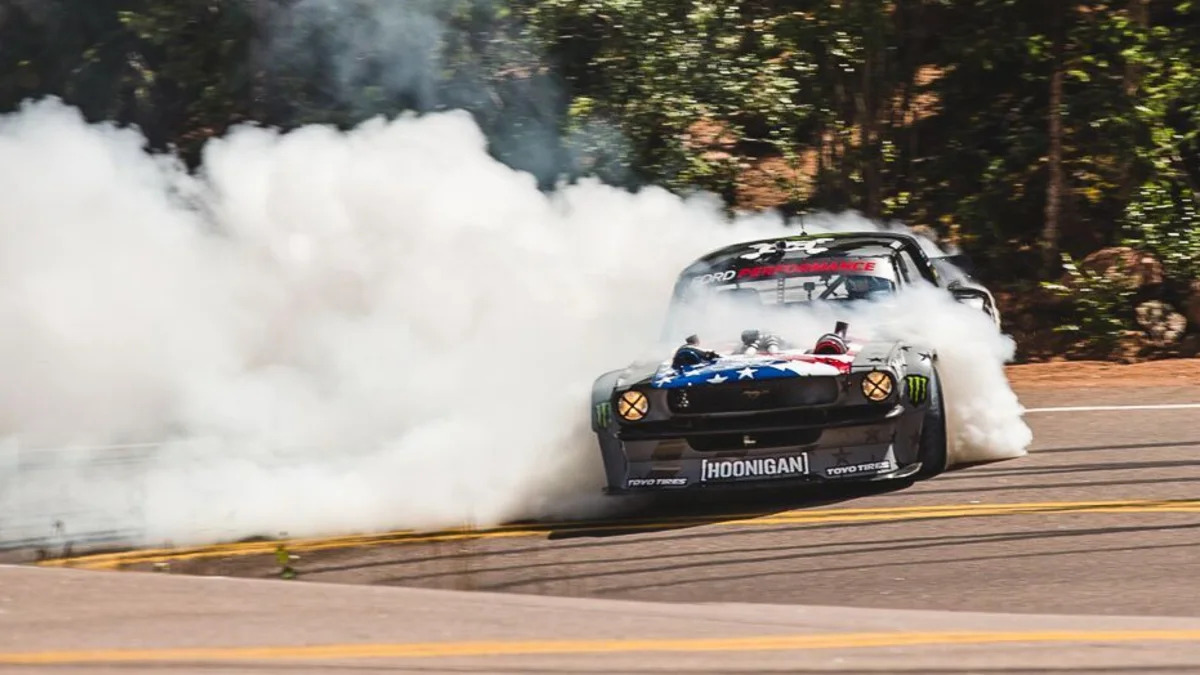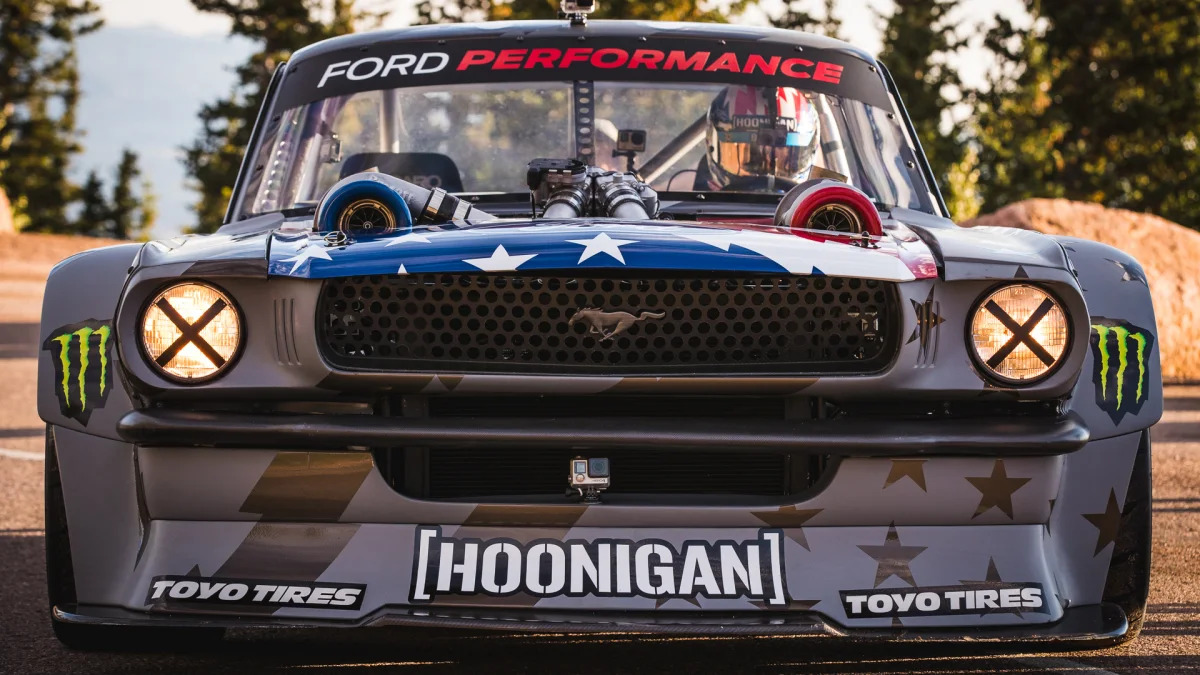11 Reasons Why We Love the 1,400 HP Hoonicorn V2
Sep 25, 2017

-

- Image Credit: Hoonigan Media Machine
Ken Block’s all-wheel-drive 1965 Ford Mustang rebuilt for Climbkhana
I first saw her in an aging warehouse on the east side of downtown Los Angeles. A raven-skinned beauty, her skin glistened under diffused sunlight seeping in from a row of windows. She didn’t have to move to make her presence known, standing on the worn concrete was enough. Her breathy voice first caught my attention, and her curves kept it there. She was wearing a chain.
A familiar face saddled up to her. Alas, she belonged to another. Under his coaxing, she, the Hoonicorn, roared to life, spinning not just her rear tires in ultra slow-mo, but her front ones as well, glorious smoke billowing out from all four wheel wells. It was love at first sight, Mustang purists be damned. That was her in Gymkhana 7, nearly three years ago. Now, after a rigorous fitness regimen to get ready to tackle the 14,115-foot elevation of Pikes Peak for Climbkhana, she’s back and lovelier than ever. Here are 11 reasons why Ken Block’s Hoonicorn V2 holds our collective heart. -
- Image Credit: Hoonigan Media Machine
1. It's not what you'd expect
The Hoonicorn started as a 1965 Mustang notchback. Ken Block purposefully avoided the more popular fastback design, a decision that better matches the unorthodox powertrain. Why build what everyone else has built? -
- Image Credit: Hoonigan Media Machine
2. It has pedigree builders
The Hoonicorn was originally worked on by RTR, Formula Drift Champion Vaughn Gittin Jr.’s tuning shop dedicated to modifying Mustangs. The build strategy resulted in a tubular-frame chassis that’s been seam-welded and reinforced. The body panels are all carbon fiber and designed in conjunction with Ken Block and the Hoonigan team.
-
- Image Credit: Hoonigan Media Machine
3. It's way more powerful than the old one
In its original form, the Hoonicorn relied on a naturally aspirated 6.7-liter Roush Yates V8 engine that produced 845 hp, plenty enough to rip through the streets of Los Angeles. The Hoonicorn V2 produces 1,400 hp, an increase of more than 65 percent. -
- Image Credit: Hoonigan Media Machine
4. It was purpose-built for Pikes Peak's high altitude
The 1,400 hp figure wasn’t just to make an impressive spec sheet. It was necessary to compensate for the loss of power from the low-denisty air at Pikes Peak's 14,000-foot elevation. In order to hit 1,400, two Garrett GTX3584RS turbochargers were bolted up to the Roush V8, and the Motec M150 ECU was retuned. -
- Image Credit: Hoonigan Media Machine
5. It's even powerful for Block
The Hoonicorn V2 is the most powerful car Ken Block has ever driven. His ride in World Rallycross, the Ford Focus RS RX, made 600 horsepower, less than half that of the Hoonicorn V2. -
- Image Credit: Hoonigan Media Machine
6. It's actually a little dangerous
For fuel, the buffed Hoonicorn runs methanol due to its ability to keep temperatures low. Despite its two turbos, the ’65 Mustang does not require the use of any intercoolers. Wonder why Ken Block is wearing a mask? It’s because the fumes from methanol are toxic, burning eyes and lungs. If that isn’t frightening enough, methanol fires are nearly invisible in sunlight, as the flames are colorless and produce no smoke. -
- Image Credit: Hoonigan Media Machine
7. V2 came together quickly
It took two years to build the original Hoonicorn. It took an additional three months to massage it into its current form. -
- Image Credit: Hoonigan Media Machine
8. It has some fancy suspension
The original first-gen Mustang shared the coil spring front and leaf spring rear suspension out of a Ford Falcon. The Hoonicorn Mustang employs pushrod suspension shared in Formula 1 race cars. -
- Image Credit: Hoonigan Media Machine
9. It's specially designed to destroy special tires
To put down four tire patches during its launches, the Hoonicorn uses a Dakar Rally-spec all-wheel-drive transmission from Sadev, a French company. The 18 x 10.5-inch Fifteen52 R40 wheels are shod with Toyo R888R tires using a special compound developed specifically for Ken Block and Climbkhana. -
- Image Credit: Hoonigan Media Machine
10. It has a hoon's handbrake
The handbrake on the Hoonicorn opens the center clutch pack to allow the rear wheels to be locked up without stalling the motor, important for hooning. -
- Image Credit: Hoonigan Media Machine
11. It's one part of a trilogy
There is a Hoonicorn V3 in the works. Heart be still.


